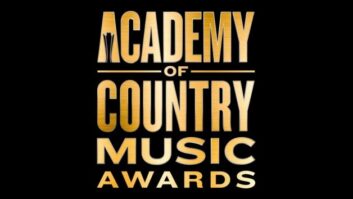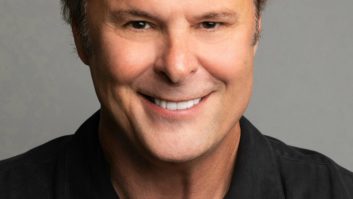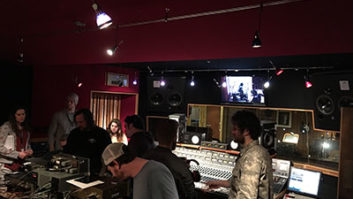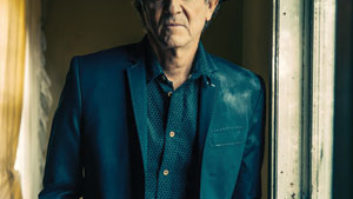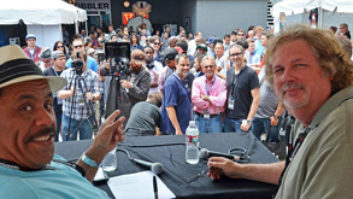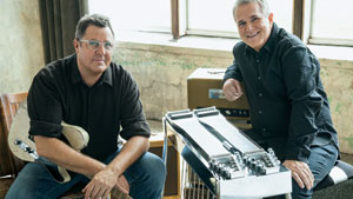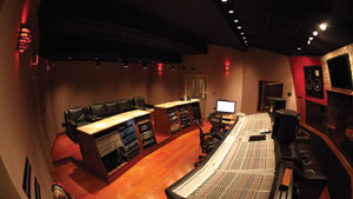
It wasn’t easy to catch up with Justin Niebank. A Nashville-based producer/engineer with a penchant for roots music, Niebank was in the middle of three projects the week I first tried to reach him: mixing for Brad Paisley, cutting vocals with Rebecca Lynn Howard and recording a Keith Urban single.
As his very respectable credits demonstrate, Niebank is equally comfortable recording, mixing and producing. His engineering clients include George Strait, Delbert McClinton and Vince Gill, among others, and he’s handled production chores for such artists as Marty Stuart, Blues Traveler and Nicole C. Mullen.
Fortunately for me, Niebank was heading for a quick busman’s holiday at the New Orleans Jazz Fest to kick back and check out the music, including a set by The Iguanas, whose just-released Plastic Silver 9-Volt Heart he’d produced. In typically efficient Niebank style, he and his wife, who raises horses, were also taking the opportunity to check out a noted Big Easy-area horse trainer. On a break from that business, he found a cell phone-friendly spot outside the barn and gave me a call. With no time to waste, the basics were quickly established: Chicago native, childhood music fanatic, electric bass player. The story goes on from there.
How did you go from playing to recording?
I’d been recording as a hobby. But once I got in a studio, I was totally jazzed. I knew that’s what I wanted to do. I started out doing jingles, then I began doing records for Alligator Records, a blues label out of Chicago. I must have done over 20 records for them [including Albert Collins’ Grammy™-winning Showdown]. As a result of those records getting attention, I worked with Barry Beckett from the Muscle Shoals rhythm section, which I totally jumped on. Any opportunity I had to get closer to the source of real American music was what I wanted. And that took me to Nashville.
From jingles to blues is a pretty big jump.
At the time, I just wanted to get my chops together. People may pooh-pooh jingles, but if you’re a musician or an engineer, they’re a fantastic way to develop your chops and learn how to cut to the chase, which, to me, is probably the most important thing for an engineer to know: how to keep momentum going and get the gig done so the technical side is invisible to the creative side.
Doing jingles, I could work on three or four different kinds of music in one day. Bruce Iglauer, who ran Alligator Records and was in the middle of a Johnny Winter record, heard through the grapevine about my engineering and gave me a shot. Then I was doing jingles all day and blues records at night.
Do you think you have an engineering style?
I like to record performances; I don’t like to record microphones. I love to be involved in the environment that’s created when the music is bigger than anyone in the room. I enjoy more live, organic recording processes. Not to mean that I’m not jazzed by technical stuff: I do a lot of sequencing and I love using computers for that. But, ultimately, give me a spellbinding performance. That’s what I want to record.
In that case, you’re lucky to live in Nashville.
Well, I usually do a wide variety of music, not just country. I had a session with a singer [Rebecca Lynn Howard] yesterday that was just jaw-dropping. Everyone looked at each other and went, “Yeah, this is why we do what we do.”
What equipment do you like to work on?
I’ll work on anything. I’m pretty typical in that I love great old Neve and API stuff for recording. I love putting things through tubes and getting them all flamed up. At the same time, there are a lot of newer pieces of gear I like. But even using new gear, I’m still drawn to the sound of great old recordings, the ones from L.A. in the late ’50s and ’60s, and the great English recordings from the late ’60s and ’70s. Those are still the barometers for me.
Like most engineers, I’m a complete gear freak: I’m always looking for new things and wanting to try the newest, coolest thing that might get me closer to what I hear in my head. I’m really taken with the Empirical Lab stuff: the Fatso and the Distressor. I’ve been messing around with the Chandler EMI compressor. That rocks. I also really like the new Universal Audio 610 mic pre’s. One of my other favorite pieces of gear is the TC Electronic M3000 reverb. Those are all in my collection of stuff that makes me go, “God, I love this!”
What do you use the Fatso for?
The thing that’s so cool about the Fatso is, I want to try it on all sorts of different things; it’s not just my drum mix compressor. But when I track, I tend to put it across my overhead mics. When I mix, I’ve used it as a drum submix compressor. I’ve also had it after another compressor on the submix to give that little bit of tape-compression sound. I use it across the kick and the snare for that tape-saturation sound, and I’ve also used it across vocals to warm them up ever so slightly.
It’s got a wide range. You could use it strictly for tape saturation — almost like a limiter — but it also adds a little different distortion that’s very pleasing. You can also use it as sort of a high-end de-esser; once again, emulating tape compression of the high end.
What about the Chandler EMI?
I’ve used it as my two-mix compressor on its Compression mode, and it did hearken back to that late-’60s Abbey Road Studio 3 sound. On another mix, where I thought the drum mics were a little flaccid, I used it in the Limiting mode and it really helped bring out the fire in the track. The attack times are set, but release is variable. I tend to use a pretty fast release, because I’m an American guy in the 21st century and I want everything to pop!
What’s your recording format of choice?
I’ve been a huge fan since day one of the RADAR system. That’s been my main digital format, and I still cut RADAR and then transfer into Nuendo, which is my DAW of choice. I’m not a Pro Tools guy, although, obviously, it’s the most used multitrack on most of the projects I work on. That’s fine with me; but for my own projects, I like to use Nuendo.
For my taste, it does sound better. It also seems more intuitive, more fluid. I don’t feel like I’m waiting for things. For me, it’s elegant and easy, and it sounds “killah.” I’ve got nothing bad to say about Pro Tools. I could say something bad about people over-using it….
Let’s talk about the latest Iguanas record that you produced and engineered.
We cut it at The Castle in Franklin, just outside of Nashville. We tried to cut it as organic, live and vibe-y as possible. I used a lot of ribbon mics and a lot of minimal miking to try to create space and room around the instruments, while still getting the sense of the guys playing together.
The overdubs were down in New Orleans at one guy’s house. I took Nuendo and a laptop and did all of the overdubs on them. We did vocals and guitars and saxes and weird noises during the day, and I’d go back to my hotel at night and comp vocals and make rough mixes. In fact, a lot of the mixes I did on headphones in the hotel were the basis for the final mixes. I took the laptop home and transferred to my main computer and we mixed off of Nuendo.
It sounds like you’re into “get it right when you record it.”
If there’s one thing I’ve learned during the past five years of trying to push my own personal bar up, it’s that when I get to the mix, I want to be able to push the faders up in a row and go, “There’s the damn record.” I’ve had a couple of rough mixes I’ve done that become hit singles, so I’m very aware that you can have roughs that you have to beat when you go to mix. The rough on Keith Urban’s “But for the Grace of God” that we spent about 45 minutes on after we’d finished background vocals was his first Number One record.
Not to make too big a deal out of it, but it’s nice to know that sometimes that kind of thing can make it through the filter. Sometimes, all of the whistles and bells can get you away from the song and the feel.
Describe your setup at The Castle. Did you use iso rooms?
We used a couple of different drum setups. For the old, classic thing of everyone leaking into each other’s mics, we put the drum kit out in the room with everyone, and I only used three mics on it. Another setup in another room was more traditional.
Then for every song, we cast a different setup: We’d move amps around, sometimes isolate them, and sometimes have all of them in the same room blowing into each other. We didn’t just go in and roll tape on every song; we’d discuss how the sound would reflect on it first.
Okay, setup “A” with three mics on the drums. What three mics?
I’m a ribbon mic fanatic; I own way too many of them. I had my old, funky Russian Oktava, a small ribbon mic, on the kick; a [Neumann] U47 as an overhead; and another ribbon mic, a Coles, out in the room.
A mono setup.
Well, on certain songs, I’d pan the overhead and the room mic slightly left and right.
What was the more traditional drum mic setup?
That was off in a drum booth, actually sort of a porch off of the side because The Castle is like an old house: It has a lot of stone. It’s not carpeted, but there were drapes behind the drums. I tend to like softer surfaces behind drums to focus the cymbals and make the sound kick forward. I used standard mics: a [AKG] D112 on the kick, a [Shure] SM57 and a [AKG] 451 on the top of the snare, and a [Shure] SM81 on the bottom. I’ve been really enjoying the Audio-Technica ATM-25s on the toms. For the overhead, I used the new RØDE NT4 stereo mic. For room mics, I used a Coles ribbon mic, set up sort of ripping off the [Glyn and Andy] Johns brothers, and I filled out the room mic with an RCA 44 [pointed at the] kick drum.
The third setup was sort of in-between. There was a door between the two rooms, and we’d kind of mix and match, using the leakage out of the drum booth into the main room.
What about bass?
Bass we’d always go direct. But I also have a vintage Ampeg B15 amp that we’d run. I think on that we mostly used a [AKG] 414 in omni. Other times, we’d use a Coles set a good six feet off.
What about bass EQ and compression?
>No EQ. Distressor and Avalon direct box.
Guitars?
I have an iso box — an enclosed speaker cabinet — made by Randall that has a 12-inch speaker. I put a Royer 121 in there, and we did the bajo sexto [12-string Mexican bass guitar] and some guitars using that. If on certain songs I wanted more leakage, I’d just lift the lid.
For the guitar amps, I have this new switcher box, the RD7 Radial Injector, made by Radikal Technologies that allows me to set up a row of half-a-dozen amplifiers and try different combinations. It’s a great box, and it absolutely proved itself on this album. I also took it direct, which I ran into the computer. Later on, I’d run the direct line through Amplitude or other plug-ins to supplement the sound of a solo, or to do things like adding some Leslie guitar on the B section of a song.
You didn’t cut saxes live, though.
Sure we did. One of them was in the iso and the other guy was out in the room with the guitars and the bass going. One of my favorite sax solos on the record was cut live that way. I think there’s that indescribable thing that happens with leakage that you just can’t get with reverb and plug-ins.
There’s a legendary Bay Area engineer, Fred Catero, who used to say, “Leakage is my friend.”
It’s the best. Part of an engineer’s job is to provide as many options as possible and not to back people into corners. A lot of times, that makes you want to just go ahead and separate everything, because that way, you’re not going to be in any trouble. But every time I work on a project where there’s leakage, my assistant and I always look at each other and say, “This is the way it has to be!” You can’t always do it that way, but it thrills me when it happens.
What sax mics did you use?
RCA DX77s, a U47 and we tried one of the new Oktava ribbon mics on a few songs.
Are you one of those guys who likes to spend a long time getting things organized on the first day?
Both when I mix and when I record, I like to have all of my options up on the board. So as the creative ideas fly, it’s not, “Okay guys, give us three hours while we set up this next thing.” I like to have it ready to go. And when I mix, I always have everything plugged in the same place on the console.
I spend a fair amount of time getting set up, but I still like to work pretty fast. [For The Iguanas], we set up for six hours and I thought that was a long time. Maybe that’s left over from my jingle days: “What, it takes longer than half-an-hour to set up? Are you kidding me?”
What’s your home studio like?
I live on a farm outside of Franklin, and I built a small studio, attached to my house, just for overdubs. It ended up being a really great little place to do small, low-budget records and some small mixing. We did the Patty Loveless Mountain Soul record there. It’s really good for mountain and bluegrass records and for small ensembles. I try not to spend too much time there because I like to spread [the work] out if I have the opportunity. I really feel like it’s my obligation to give work to as many studios as I can in Nashville.
What’s the console?
A [Yamaha] 02R96. I love it; it’s the greatest.
How do you choose whether to mix in Nuendo or on the 02R?
If I’ve got a rough mix that’s already feeling good and I’ve got it coming through Nuendo, then I’ll just stay with that. But if it’s not moving me, I’ll go multichannel and start over on the 02R.
What are your monitors?
I have a pair of Tannoy Golds with Mastering Lab crossovers that I’ve been using for 12 years and a pair of Genelec 1031As. At home, I still use NS-10s with the Yamaha subwoofer.
Do you have some goals for the rest of the year?
To try to be a lot better than I am today, and to be among the people trying to get more soulful records on the radio. And I want to see Tony Brown [who suffered a serious accident in April] back in the producer’s chair. He’s been a big part of my life in Nashville. If I had only one goal this year, it would be to see Tony back in the game.
Justin Niebank Selected DiscographyP = producer; E = engineer; M = mixer
Blues Traveler:Travelogue: Blues Traveler Classics (P/E/M, 2002)
Confederate Railroad:Rockin’ Country Party Pack (M, 2000)
Robert Cray:Heavy Picks: The Robert Cray Collection (E/M, 1999)
Vince Gill:Next Big Thing (E/M, 2003)
George Jones:The Rock: Stone Cold Country 2001 (E/M, 2001)
Marty Lloyd:Marigold (P/E/M and various instruments, 2003)
Patty Loveless:Bluegrass and White Snow: A Mountain Christmas (E/M, 2002), Mountain Soul (E/M, 2001)
Shane McAnally:Shane McAnally (M, 2000)
Delbert McClinton:Nothing Personal (E/M, 2001)
John Mellencamp:Mr. Happy Go Lucky (E, 1996)
Nicole C. Mullen:Christmas in Black and White (P/E/M, 2002), Talk About It (P/E/M and various instruments, 2001), Nicole C. Mullen (P/E/M and various instruments, 2000)
Veronique Sanson:D’Un Papillon À Une Étoile (E/M, 1999), Indestructible (E/M, 1998), Comme Ils L’Imaginant (M, 1996)
George Strait:For the Last Time: Live From the Astrodome (M, 2003)
Marty Stuart:The Millenium Collection: The Best of Marty Stuart (P, 2002)
Pam Tillis:Thunder and Roses (E/M, 2001)
Keith Urban:Golden Road (E/M, 2002)
Chely Wright:Never Love You Enough (M, 2001)
